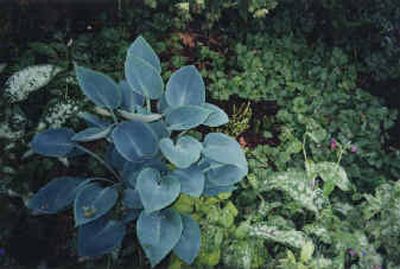Many factors go into creating balance in garden

What most of us value as we walk through a natural landscape is the diversity of plant materials arranged in a seemingly orderly manner, which we recognize as balance. Today’s article explores diversity and balance in the garden, with special attention to shade gardens.
For many shade gardeners, the hosta is the foundation plant. Originating in China, Korea and Japan, and now with more than 5,000 species and cultivars available, the diversity within the genus is immense. The hosta is the largest selling ornamental garden plant in the country.
Prized primarily for their foliage, hostas vary in growth and leaf size. They are shades of green, blue, and yellow (gold) as basic colors with edge stripes in varied intensities of white, yellow, blue or green. Some leaves are green on the top, white on the underside. Leaves grow as heart-shaped, lanced, curled, puckered, pie-crusty, deeply ribbed or twisty. Many are variegated with coloring in tight, definite patterns, or have erratic splashes of contrasting color, or present mottled, marbled hues.
Some hostas clump, others spread and drift. The petioles (stems) range from deep red to deep green. Flowers (some fragrant, some not) are found usually on tall spikes, ranging in color from white to lavender to purple. Who needs more diversity in a garden than what is offered by several dozen — or 50 or 100 or more — hostas? Five thousand, anyone?
Writing in The Hosta Journal recently, W. George Schmid described a redesign of a former “sea of hostas” on his half-acre suburban lot. He began “observing how Nature balances its plant communities.”
In a few years time, he relocated hostas and brought in native plants to replace hundreds of hostas he gave to family and friends. Diversity was thus enhanced; still, his garden lacked balance. To find balance, he selected hardy perennials not native in Georgia where he lives. These he refers to as “exotics” though they are not necessarily unusual or rare. As his satisfaction with the pairing and coupling experiments increased, he realized that “the hostas … looked so much better combined with the new plants than they did when mixed in with a bunch of other hostas.”
Even after five decades of gardening, Schmid still sought out multiple sources for ideas to fuel his adventure and garden transformation. Each of us can find botanical and gardening books in our bookstores and libraries. (The Sunset Western Garden Book should be required reading.) The Internet is an inexhaustible resource. (A search with just the name of one of the plants listed below will get you connected.) Conversations with other gardeners, and your own gardening ideas and experiences are good starting points, too.
When a collector like Schmid questions the redundancy of a single genus garden, however diverse, the issue of balance of plant material is raised. Consider these suitable companions: heucheras (coral bells), ferns, hellebores, hydrangeas, dwarf conifers, pulmonaria, sedges, sedums, Solomon seals, arum, Japanese maples, bush and tree peonies, epimediums and a host of ground covers with colorful foliage and flowers.
Armed with new ideas, the gardener needs to weigh several factors to create this new balance. Plant factors to consider include color, texture, plant size (height and spread), leaf shape, florescence (frequency and duration of flowering) and seasonality (early spring, summer, late summer, autumn; yes, even winter). Other factors to be mindful of include drought tolerance, water and soil requirements, and, importantly, attraction of birds, bees, and butterflies into the garden to complement the diversity and balances of plant life.
We can find no better resource than the book written by Schmid himself: “An Encyclopedia of Shade Perennials” (Timber Press, 1991) based on his experiment in garden redesign.
Two final pieces of Schmid wisdom: “Seeking nature as a model does not mean you must copy. We can never attain the beauty of nature in our gardens.” But this should not stop us from challenging nature with our own creations. When we create gardens that express diversity and balance, we find, as he found: “Nature gardens with an ever changing, seasonal rhythm.”